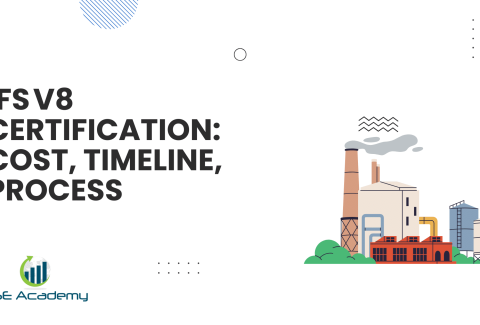IFS V8 Transition Guide: Moving from IFS V7
Last Updated on November 19, 2025 by Melissa Lazaro
Why the Shift to IFS V8 Matters and What’s Changing
Transitioning to a new version of a food-safety standard can feel overwhelming, especially when the current system is already working. IFS V8 isn’t a complete rewrite of V7, but it does strengthen expectations around consistency, behavior-based evidence, and alignment with global food-safety principles, including updated Codex requirements and clearer auditor interpretation rules.
In my experience supporting food manufacturing, logistics, and packaging organizations through standard upgrades, the sites that transition successfully are the ones that follow a structured plan instead of rushing just before the certification audit. This guide breaks down the transition into practical steps so you can update your system with clarity and confidence — not last-minute stress.
What’s New in IFS V8: Key Changes Compared to IFS V7
IFS V8 sharpens several areas that auditors are now expected to evaluate more consistently. The framework remains recognizable, but expectations have evolved — especially in areas connected to operational behavior, risk-based decision-making, and supplier oversight.
Here’s what stands out in V8:
- Clearer and stronger scoring logic
- Enhanced expectations for Food Safety Culture
- Updated terminology and clause interpretations
- More emphasis on documented justification rather than assumptions
- Stronger alignment with current Codex HACCP requirements
Thinking of V8 as a refinement helps — your system doesn’t need rebuilding, but alignment and evidence improvement are essential.
 Step 1: Conduct an IFS V8 Gap-Analysis (Your Starting Point)
Step 1: Conduct an IFS V8 Gap-Analysis (Your Starting Point)
A structured gap-analysis is the foundation of a smooth transition. It allows you to see what already aligns, what needs adjustment, and what may require completely new controls or documentation.
A strong gap-analysis includes:
- Clause-by-clause comparison
- Documented requirement impact evaluation
- Assessment of operational alignment — not just paperwork
- Clear prioritization based on risk and audit relevance
Teams who skip this step often end up making unnecessary changes or overlook areas auditors will focus on.
Step 2: Update Documentation, Records, and Templates
Once gaps are identified, the next phase is updating documentation and controlled forms. This includes the manual, SOPs, logs, and any controlled tool used for operational proof.
Core focus points during updates include:
- Ensuring documentation terminology matches IFS V8 language
- Adding measurable Food Safety Culture indicators
- Updating record templates where new evidence expectations apply
- Revising descriptions of CCP/OPRP validation logic
- Strengthening change-control documentation
A helpful rule: if it’s written in policy, there must be evidence of implementation.
Step 3: Strengthen Supplier Approval and Monitoring Controls
Supplier compliance expectations have grown in IFS V8, especially around risk-based controls, food fraud, and ongoing performance monitoring.
Key areas to review include:
- Supplier agreements — now requiring clearer clauses
- Risk-based approval approach
- Documented monitoring frequency tied to supplier category
- Evidence of supplier performance evaluation
Many sites realized their supplier documentation was compliant in theory — but not structured enough to demonstrate ongoing monitoring in practice.
Step 4: Refresh HACCP/HARPC and Risk-Based Controls
IFS V8 requires HACCP documentation to reflect updated Codex expectations. This change affects hazard justification, decision-tree use, and validation requirements.
During this phase, review:
- Hazard analysis methodology
- CCP and OPRP justification
- Validation evidence — especially for allergens, critical equipment, and environmental controls
- Verification records and frequency
This is also a good time to confirm that operational controls match documented logic.
Step 5: Update Training and Competency Programs Including Food Safety Culture
IFS V8 places more importance on evidence of awareness, competency, and engagement — not just completed training records.
Strengthen training programs by focusing on:
- Role-based competency standards
- Culture behaviors tied to KPIs
- Scenario-based operator coaching
- Documented reinforcement activities such as toolbox talks
A single example worth mentioning: one facility saw major improvement after replacing passive slideshow training with short, scenario-based exercises during shift meetings. Operators became more confident answering auditor questions because they understood the why — not just the what.
Step 6: Adjust Internal Audit Programs to Match IFS V8 Expectations
Internal audits must now reflect V8 scoring and clause interpretation. Updating audit tools is essential so internal findings align with how certification auditors will evaluate compliance.
This update should include:
- V8-aligned scoring
- KO focus points
- Interview-based verification
- Evidence sampling rather than document review alone
Auditors are placing stronger emphasis on consistency — in documentation, in execution, and across departments.
Step 7: Run a Mock IFS V8 Certification Audit
A mock audit validates whether the system is fully aligned and whether staff can demonstrate competency.
A well-executed mock includes:
- Full site walkthrough
- Document and record sampling
- Interview questions across all roles
- KO clause validation
- Scoring aligned with V8
The purpose isn’t perfection — it’s clarity. A mock audit provides insight into what still needs refinement before the certification audit.
Timeline & Priority Strategy: How Long the Transition Should Take
Transition time varies depending on maturity, but most facilities follow a timeline similar to this:
| Phase | Duration | Focus Area |
|---|---|---|
| Gap-Analysis | 2–4 weeks | Identify what changed |
| Documentation Updates | 4–8 weeks | Manual, SOPs, logs |
| Implementation & Training | 4–10 weeks | Competency and operational alignment |
| Internal Audit & Mock Audit | 2–6 weeks | Validate readiness |
High-risk and KO-aligned requirements should always be addressed first.
FAQs — Moving from IFS V7 to IFS V8
1. Do we need to rebuild our system completely?
No. Most systems require alignment, not full redesign.
2. How do we know when we’re ready for the official audit?
A full internal audit aligned with V8 scoring is the clearest indicator.
3. Will auditors evaluate differently under V8?
Expect more consistency, more evidence sampling, and more operational interviews.
Conclusion: A Structured Transition Makes IFS V8 Achievable
IFS V8 rewards clarity, operational consistency, and evidence-driven food safety practices. With a structured transition plan, updated systems, and internal alignment, the certification audit becomes predictable — not stressful.
If you follow the sequence — understand the changes, update documentation, strengthen execution, train teams, audit internally, and run a mock — the transition becomes straightforward and manageable.
Melissa Lavaro is a seasoned ISO consultant and an enthusiastic advocate for quality management standards. With a rich experience in conducting audits and providing consultancy services, Melissa specializes in helping organizations implement and adapt to ISO standards. Her passion for quality management is evident in her hands-on approach and deep understanding of the regulatory frameworks. Melissa’s expertise and energetic commitment make her a sought-after consultant, dedicated to elevating organizational compliance and performance through practical, insightful guidance.








